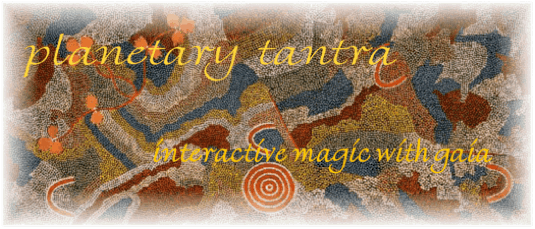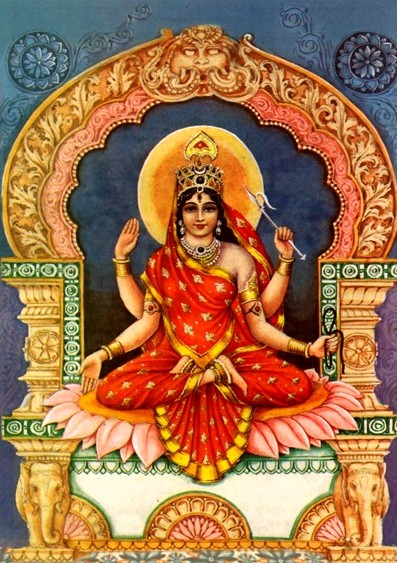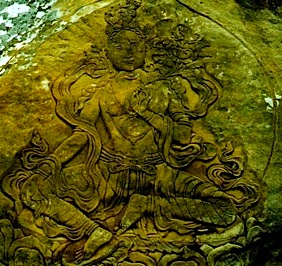| Site Guide |
| Tantra Tour |
| Gaian Tantra Vow |
| Foundations |
| SHAKTI CLUSTER | Dakini Calendar |
| Terma | Sierra de Libar |
BULL :: Bhuvaneshvari and Tara
(Double Shift)
She Whose Body is This Beautiful World
and
The Wrathful Green Tara, The Selector
Lunar cycle 2009: begins April 26 with the sunset crescent in the BULL, near the Pleiades - ends May 24 with the new moon (71° ecliptic scale) conjunct Aldebaran in the eye of the BULL
Bhuvaneshvari, embodiment of material and sensory richness: associated specifically with the Pleiades in the shoulder of the BULL. This open cluster of young bluish stars, one of the most celebrated sights in world-wide sky lore, may also be visualized as the head of an enormous vulture, or a spindle.
Tara: associated specifically with Aldebaran, the massive golden star in the eye of the BULL. Since the 1970s, astronomers have known that the sightline to the bull's-eye star (72 degrees on the ecliptic) indicates the direction of the ALG, the Apex of the Local Group. This apex is the point toward which the twenty-four galaxies of the local group to which our galaxy belongs are converging, by contrast to the collective dispersion or flowing away of all galaxies in all directions in cosmic space. Tara the Selector holds this direction.
The lunar shakti cycle signaled by the sunset crescent in the constellation of the BULL indicates a rare occurence, a "double shift" under the Mahavidyas Bhuvaneshvari and Tara. In this instance, the unique form of the Wrathful Green Tara applies, not the usual sweet and safe form of Tara, who is regarded as the guardian deity of Tibet and the savior or liberator of Tibetan Buddhism. In the frame of dakini instruction, Tara is called the Selector. She might also be called the Eliminator. The two devatas, Bhuvaneshvari and Tara, work together: Tara eliminates any people, situations, beliefs, or conditions that are incompatible with your fullest enjoyment of the richness of the material and sensory world, the body of Bhuvaneshvari. In her form as a wrathful goddess, Tara selects those people and conditions that enrich your life and bring you unimpeded pleasure, and Bhuvaneshvari attunes and amplifies what is thus selected so that it conforms to, and enables, the realization of your highest desire.
Tara's compassion is manifest in allowing people to count themselves out of beauty and enlightenment, if they wish to do so. She does not tyranically select anyone, nor does she gather together an elite group of the privileged or saved. The privilege of complete pleasure and self-liberation is open to all, with the option to count yourself out, to elect not to participate. Tara is the representation and agent both of selection and deselection. She presents the proof that self-liberation cannot be either faulted or disregarded, and that it excludes no one.
There was an element of the Wrathful Green Tara in my experience of the Ronda Moment. I realized then that my enlightenment could not be my own, that it had to belong to anyone who recognized it in me, or merely allowed the possibility of it, because precisely that kind of recognition triggers the self-liberation of the illusional, separated mind. "I have only this to tell you about my enlightenment: it's yours." There is no enlightenment in a void, but only in relation. Enlightenment is contagious, it spreads through recognition. That is the essential message I wish to convey about the social and interpersonal significance of the Ronda Moment. That is my final word to those who would discount and disregard my realization, such as it is, and its flowering in Planetary Tantra. Typically, people will count themselves out of enlightenment with the ineffable beauty and joy it engenders, because that act of recognition is a paradoxical event of self-dissolution uniquely found in facing another: as long as you cannot face another in naked recognition that their enlightened nature is identical to your own, you cannot see your true connection with them. So you are compelled to separate from them. As I now understand it now, Tara in her art of selection does not enforce or instigate these separations, but she organizes them for the highest truth of all concerned. I would say that Tara in the Shakti Cluster, acting as the Selector, designs the patterned fate of human relationships around the spaces induced by withholding recognition of our enlightened nature from each other. |
Traditional icon: Bhuvaneshvari is vermilion-colored. She has three eyes and her body is adorned with strands of glittering jewels. Seated on a red lotus, she holds a red lotus and a bowl full of black pearls. Her expression is peaceful. inviting, aimable.
The Wrathful Tara is dark, moulting green, seated on a throne partially concealed in rampant jungle foliage. She has eight arms holding various instruments, and wears the five-skull crown of the Diamond Sky Dakinis and other Tantric divinities and wrathful guardians. In her soft-core or non-wrathful version, Tara is said to be born of the tears of Avalokiteshvara, the Bodhisattva of Infinite Compassion. She vows to be reborn only as a woman and to strive for the liberation of all sentient beings. Her name from from a word meaning "bridge, that which carries across." In her wrathful form, she represents the power of discrimination inherent to the enlightened mind. Where and when the sublime is felt without inhibition, self and other converge sublimely. Her wrath is directed against everything that does not recognize and allow the immediate presence of self-liberating awareness for each person, each moment.
Origin myths:
Bhuvaneshvari: Before this world existed, Surya the sun offered to the gods a drink of soma, the divine inebriant, so that the worlds could be generated from divine ecstasy. Three realms emerges, earth, sea and sky, and the Mahavidya Sodashi entered and permeated these realms, taking the form of Bhuvaneshvari. Hence she is a form of Sodashi or Tripurasundari, Beautiful (sundari) Mistress of the Three Realms (tripura).
Tara: Traditionally, she was formed from the tears of Alavokiteshvara, the Bodhisattva of Infinite Compassion. The origins of the wrathful form of the "liberator goddess" are unknown. Tara is a fluke, for she is a full-blown deity of Tibetan Buddhism, a female Bodhisattva, yet she appears in the Shakti Cluster beside Kali, and belongs to the circle of the Mahavidyas. No scholar can explain this anomaly. It appears that she, who leads others to cross over from samsara to nirvana, has herself crossed over from the realm of liberationist aims to that of desideristic aims. As a Bodhisattva who grants personal desires, the Wrathful Green Tara deserves special attention and close study. We have much to learn about the ways and means of the Selector.
Themes, cues, associations:
Bhuvaneshvari
§ Associated ad identified with the earth more than any other Mahavidya. She is called Bhuvana, mistress of this world. Represents the five elements of the senses in their totality or unity.
§The sensory world emerges from her as a web from a spider. Cf. Spandarmat, the Persian goddess of the earth, equivalent to Gaia, and Spider Woman of Native American lore. Her domain is the planetary quantum field (web of possibilities).
§ Seed mantra: HRIM, used widely in Tantric invocation of dakinis and devatas.
§ "Her reality is immediate and her presence is immediate and accessible" (Kinsley).
§ She is the nurse of the world, a goddess of nurturing and nourishing powers. She protects and preserves all good things to eat and enjoy, sensually. The wealth of the earth.
§ Identified with the cosmic sound, shabda-brahman, the base vibration of the planet (Schumann frequency?), the created order whose essence is sound.
§ Epitome of the force of cosmic attraction, operating in personal attractions of all kinds. The attraction to all things one likes, including people, are lures to her beauty.
§ She is food. Gracious behaviour. Good manners. A mood of richness and luxury.
The Wrathful Green Tara
NOTE: Kingsley (The Ten Mahavidyas: Tantric Visions of the Divine Feminine) and Frawley (Tantric Yoga and the Wisdom Goddesses) do not identify Tara in the Mahavidya circle in the specific form of a wrathful, green-colored goddess, but I do. They treat Tara as the "Saviouress" along traditional lines, without explaining how a Tibetan deity fostering liberation from desire could be included in the circle of desideristic witches who grant all personal desires. My view of Tara in this regard is idiosyncratic.
§ In Tantricism, Tara belongs to the family of the Dhyani Buddha Amogasiddhi, matrix of All-Accomplishing Wisdom. This association is onsistent with the Mahavidya profile of Tara as a supernatural witch who grants occult powers and magical abilities. In her fierce, terrifying form she is sometimes identified with the Diamond Sky Dakini, Kurukulla (zodiacal locus: ARCHER), and with the ravenous dakini figure of the Blue She-Wolf.
§ She fosters longevity., but she is not a fertility goddess -- none of the Mahavidyas are. No devata of the Shakti Cluster supports biological fertility.
§ She favors those who practice the "left-handed path," using the five senses and their correlations, the five forbidden things (wine, sex, meat, fish, and fermented grain with psychoactive properties) for sacraments.
§ She is the remover of pride.
§ Second only to Kali in importance in the Shakti Cluster. Called Dakshina Kali, a reference to her origin in the south of India, Tamil Nadu, matrix of Dravidian culture. In this form, "she is taken to be the highest expression of wisdom (vidya), liberating knowledge" (Kinsley) ... and at the time of pralaya, at the close of the Age, she becomes furious and changes into Kali.
§ Like the other Mahavidyas, she dominates the male figure associated with her. "she reverses the expectations of the female role [in male-dominated cultures]. She is unrestrained, wild, and dominant" (Kinsley).
§ Miranda Shaw (Buddhist Goddesses of India) has an excellant chapter on Tara dealing with her wrathful aspect. This book can be read on line: Google "Wrathful Green Tara Miranda Shaw" and it comes up on top. She says that the Green Tara, in the form of Khadirivani Tara, is associated with plants, especially the acacia tree (which has psychoactive properties -- the acacia was also the tree sacred to the Egyptian cow goddess, Hathor).
Zodiacal motifs:
§ BULL associated with the power of the Great Goddess as sound. The roaring of the planetary slipstream is like the deep-throated warbling of dual exhaust pipes, massive turbines, clearly heard in a state of attention heightened by psychoactive plants or LSD. This is an objective phenomenon that can be heard by more than one person at a time. It is obvious and unmistakable, not imagined or mistaken for something else one hears.
Experiential: The actual sound is like the low pulsating roar of a Maserati at the curb. Hearing this sound, and unable to locate its source, you know that you are "down in her exhaust." This astonishing experience is closely associated with encountering the Organic Light in an oceanic flush all around and through the body. Some impressions it produces are: an hilarious sensation of well-being, the absolute certainty that you are continually healed by immersion in unending life, a surge of inexhaustible beauty that ravishes your senses, heightening of the appetite for pleasure that can never be sated, and never wants to be! Add to this the vivid realization that the planetary "exhaust" (Gaia's kinetic explusion into the slipstream of her orbital track at the rate of 64,000 miles per hour) is totally and utterly pure, without a trace of human-made pollution or chemical fouling or any kind. "Zero emission," absolutely. That is her natural state.
All these impressions, which might be designated as Bhuvaneshvari-like in nature, arise directly from auditory reception of the acoustic signature of the earth. It might be said that we are granted this specific experience of planetary acoustics through the blessing of Bhuvaneshvari, who is revered as the sensuous embodiment of cosmic sound.
21 April 2009 Andalucia



